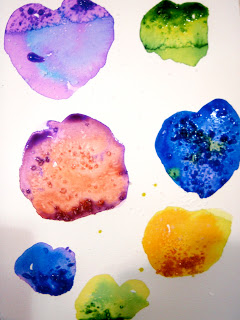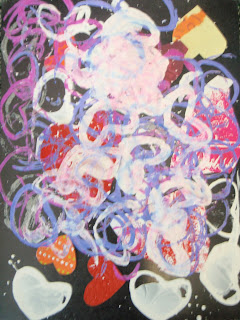Written by Elliot Eisner, an ardent arts advocate, I originally found this from the April 2011 issue of Arts & Activities magazine. It's a short, succinct argument for the importance of art in education. Here it is:
1. The arts teach children to make good judgments about qualitative relationships.Unlike much of the curriculum in which correct answers and rules prevail, in the arts, it
is judgment rather than rules that prevail.
2. The arts teach children that problems can have more than one solutionand that questions can have more than one answer.
3. The arts celebrate multiple perspectives.One of their large lessons is that there are many ways to see and interpret the world.
4. The arts teach children that in complex forms of problem solving
purposes are seldom fixed, but change with circumstance and opportunity. Learning in the arts requires the ability and a willingness to surrender to the unanticipated possibilities of the work as it unfolds.
5. The arts make vivid the fact that neither words in their literal form nor numbers exhaust what we can know. The limits of our language do not define the limits of our cognition.
6. The arts teach students that small differences can have large effects.The arts traffic in subtleties.
7. The arts teach students to think through and within a material.All art forms employ some means through which images become real.
8. The arts help children learn to say what cannot be said.When children are invited to disclose what a work of art helps them feel, they must reach into their poetic capacities to find the words that will do the job.
9. The arts enable us to have experience we can have from no other source and through such experience to discover the range and variety of what we are capable of feeling.
10. The arts' position in the school curriculum symbolizes to the young
what adults believe is important.
This is the art blog for Fayston Elementary School, located in the Mad River Valley in Central Vermont. This blog is updated frequently to showcase the artwork of Fayston's students and celebrate all things creative!
Friday, February 10, 2012
Thursday, February 9, 2012
Watercolor Painting with Analogous colors for Valentine's Day
First and second grade artists examined the color wheel closely to learn about analogous colors- colors that are next to each other on the color wheel. Students noticed how beautifully analogous colors blend together- not a brown blob in sight!
We used liquid watercolors to paint hearts on high quality watercolor paper. Artists chose two analogous colors for each heart. We also experimented with adding salt to wet paint to create amazing results. Students were productive and focused as they challenged themselves to come up with as many different combinations of analogous colors as possible.
We used liquid watercolors to paint hearts on high quality watercolor paper. Artists chose two analogous colors for each heart. We also experimented with adding salt to wet paint to create amazing results. Students were productive and focused as they challenged themselves to come up with as many different combinations of analogous colors as possible.
My Heart is Like a Zoo
Third and Fourth grade artists read "My Heart is Like a Zoo," by Michael Hall. This is a book of animal similies where all of the animal illustrations are made with hearts. What could be more fun as we get ready for Valentine's Day? Students used colored paper to collage their own animals based on Michael Hall's creations.
Want to see a beaver moonwalk and learn more about "My Heart is Like a Zoo?" Click here!
Watch the trailer for this book to see how hall made some of his lovely heart animals.
Here are some student collages inspired by this book:
More Chinese Dragons!
Many more Chinese New Year Dragons by third and fourth grade artists have been added to the original post. Click here to check them out!
Kindergarten Pattern Hearts
It is never to early to start teaching about the principles of design and the elements of art. Kindergarten artists discussed LINES and PATTERNS before using Sharpie markers to draw a heart and fill it in using as many different types of lines and patterns as possible. We used liquid watercolors to paint the hearts. It is hard to see in the photographs, but I added pearl medium to the paints so that the hearts sparkle festively!
My example:
(I often hesitate to show an example of finished work because some artists feel that their work needs to look exactly like mine. In this case, I think having an example to refer to helped the young artists with getting the size of the hearts right and gave them some ideas for different types of lines and patterns.)
Pre-K Valentine's Day Printing Project- Part Two
Pre-K artists completed their Valentine's Day printing projects in art class today. Last week we made the large printed hearts using foam paper and printing ink. Today they cut out their prints from last week and made a collage as a surface to print onto. They could also include small hearts cut from decorative handmade paper.
For today's printing project, we bent toilet paper rolls into heart shapes and then printed hearts all over the pages. I added pearl medium and glitter to some of the paints and I added liquid soap to the white paint, so that the paint would form a bubble on the end of the tube to create a solid heart.
We made our pieces of artwork on 8"X10" black mat board so that they will stand the test of time or are frame-ready.
Thursday, February 2, 2012
Pre-K Valentine's Day Printing Project
Pre-K artists cut out heart shapes from styrofoam sheets. They decorated their hearts with a variety of different types of lines. We used printing ink to print our heart stamps. We will use our prints to make Valentines next week, just in time for Valentine's Day!
Clay Club
Clay club artists made clay masks and Oaxacan Mexican animals.
Looking at a book of Oaxacan animals for inspiration
Using molds to make clay masks

















































